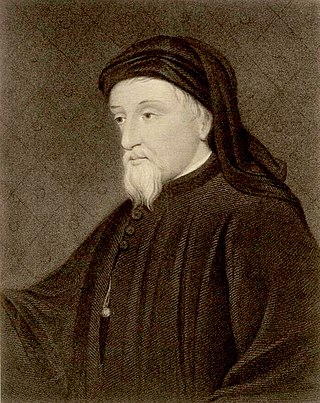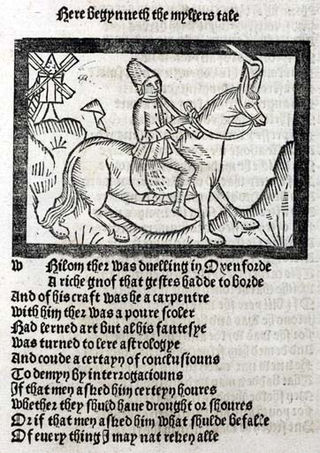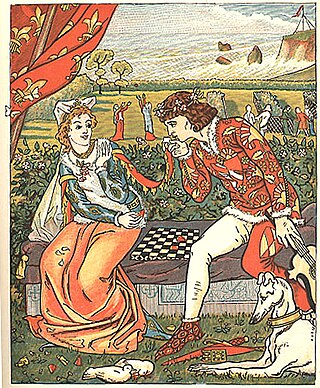
The Canterbury Tales is a collection of twenty-four stories that runs to over 17,000 lines written in Middle English by Geoffrey Chaucer between 1387 and 1400. It is widely regarded as Chaucer's magnum opus. The tales are presented as part of a story-telling contest by a group of pilgrims as they travel together from London to Canterbury to visit the shrine of Saint Thomas Becket at Canterbury Cathedral. The prize for this contest is a free meal at the Tabard Inn at Southwark on their return.

Geoffrey Chaucer was an English poet, author, and civil servant best known for The Canterbury Tales. He has been called the "father of English literature", or, alternatively, the "father of English poetry". He was the first writer to be buried in what has since come to be called Poets' Corner, in Westminster Abbey. Chaucer also gained fame as a philosopher and astronomer, composing the scientific A Treatise on the Astrolabe for his 10-year-old son Lewis. He maintained a career in the civil service as a bureaucrat, courtier, diplomat, and member of parliament.

Middle English is a form of the English language that was spoken after the Norman Conquest of 1066, until the late 15th century. The English language underwent distinct variations and developments following the Old English period. Scholarly opinion varies, but the Oxford English Dictionary specifies the period when Middle English was spoken as being from 1150 to 1500. This stage of the development of the English language roughly followed the High to the Late Middle Ages.

An astrolabe is an ancient astronomical instrument that was a handheld model of the universe. Its various functions also make it an elaborate inclinometer and an analog calculation device capable of working out several kinds of problems in astronomy. In its simplest form it is a metal disc with a pattern of wires, cutouts, and perforations that allows a user to calculate astronomical positions precisely. Historically used by astronomers, it is able to measure the altitude above the horizon of a celestial body, day or night; it can be used to identify stars or planets, to determine local latitude given local time, to survey, or to triangulate. It was used in classical antiquity, the Islamic Golden Age, the European Middle Ages and the Age of Discovery for all these purposes.

The Hermetica are texts attributed to the legendary Hellenistic figure Hermes Trismegistus, a syncretic combination of the Greek god Hermes and the Egyptian god Thoth. These texts may vary widely in content and purpose, but are usually subdivided into two main categories, the "technical" and "religio-philosophical" Hermetica.

The Romaunt of the Rose is a partial translation into Middle English of the French allegorical poem, Le Roman de la Rose. Originally believed to be the work of Chaucer, the Romaunt inspired controversy among 19th-century scholars when parts of the text were found to differ in style from Chaucer's other works. Also the text was found to contain three distinct fragments of translation. Together, the fragments—A, B, and C—provide a translation of approximately one-third of Le Roman.

The Parlement of Foules, also called the Parlement of Briddes or the Assemble of Foules, is a poem by Geoffrey Chaucer made up of approximately 700 lines. The poem, which is in the form of a dream vision in rhyme royal stanza, contains one of the earliest references to the idea that St. Valentine's Day is a special day for lovers.

"The Parson's Tale" seems, from the evidence of its prologue, to have been intended as the final tale of Geoffrey Chaucer's poetic cycle The Canterbury Tales. The "tale", which is the longest of all the surviving contributions by Chaucer's pilgrims, is in fact neither a story nor a poem, but a long and unrelieved prose treatise on penance. Critics and readers are generally unclear what rhetorical effect Chaucer may have intended by ending his cycle in this unlikely, extra-generic fashion.

"The Miller's Tale" is the second of Geoffrey Chaucer's Canterbury Tales (1380s–1390s), told by the drunken miller Robin to "quite" "The Knight's Tale". The Miller's Prologue is the first "quite" that occurs in the tales.

"The Franklin's Tale" is one of The Canterbury Tales by Geoffrey Chaucer. It focuses on issues of providence, truth, generosity and gentillesse in human relationships.

Abū Isḥāq Ibrāhīm ibn Yaḥyā al-Naqqāsh al-Zarqālī al-Tujibi ; also known as Al-Zarkali or Ibn Zarqala (1029–1100), was an Arab maker of astronomical instruments and an astrologer from the western part of the Islamic world.

Walter William Skeat, was a British philologist and Anglican deacon. The pre-eminent British philologist of his time, he was instrumental in developing the English language as a higher education subject in the United Kingdom.

The General Prologue is the first part of The Canterbury Tales by Geoffrey Chaucer. It introduces the frame story, in which a group of pilgrims travelling to the shrine of Thomas Becket in Canterbury agree to take part in a storytelling competition, and describes the pilgrims themselves.

Mā Shā’ Allāh ibn Athari was an 8th century Persian Jewish astrologer, astronomer, and mathematician. Originally from Khorasan he lived in Basra during the reigns of al-Manṣūr and al-Ma’mūn, and was among those who introduced astrology and astronomy to Baghdad in the late 8th and early 9th century. The bibliographer ibn al-Nadim in his Fihrist, described him "as virtuous and in his time a leader in the science of jurisprudence, i.e. the science of judgments of the stars". He served as a court astrologer for the Abbasid Caliphate and wrote numerous works on astrology in Arabic. Some Latin translations survive.

"The Canon's Yeoman's Tale" is one of The Canterbury Tales by Geoffrey Chaucer.

An equatorium is an astronomical calculating instrument. It can be used for finding the positions of the Moon, Sun, and planets without arithmetic operations, using a geometrical model to represent the position of a given celestial body.
Simon Bredon was an English astronomer, mathematician, and physician and priest. He was a member of the Merton School, Oxford, elected a Fellow of Merton c. 1330, perhaps until the year 1342, having formerly been a member of Balliol. He was a Doctor of Medicine of the University of Oxford. He left manuscripts and scientific instruments to a number of Oxford colleges, perhaps including the bequest of the Oriel astrolabe, which is now in the Museum of the History of Science.

Contact between Geoffrey Chaucer and the Italian humanists Petrarch or Boccaccio has been proposed by scholars for centuries. More recent scholarship tends to discount these earlier speculations because of lack of evidence. As Leonard Koff remarks, the story of their meeting is "a 'tydying' worthy of Chaucer himself".
Abu al‐Qasim Ahmad ibn Abd Allah ibn Umar al‐Ghafiqī ibn as-Saffar al‐Andalusi, also known as Ibn as-Saffar, was a Spanish-Arab astronomer in Al-Andalus. He worked at the school founded by his colleague Al-Majriti in Córdoba. His best-known work was a treatise on the astrolabe, a text that was in active use until the 15th century and influenced the work of Kepler. He also wrote a commentary on the Zij as-Sindhind, and measured the coordinates of Mecca.
The Equatorie of the Planetis is a 14th-century scientific work which describes the construction and use of an equatorium. It was first studied in the early 1950s by Derek J. Price, and was formerly attributed to Geoffrey Chaucer. However, in 2014 it was shown to be written in the hand of the St Albans monk John Westwyk. It is largely written in Middle English, with some additions in Latin. It is accompanied by extensive astronomical tables, with Latin headings and annotations.
























